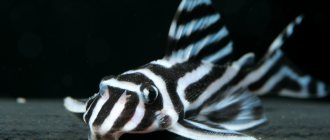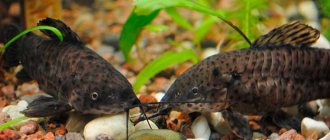Catfish is a fairly large fish with predatory habits. Lives in fresh waters of rivers and lakes. Represents the class - ray-finned fish, order - catfish, family - catfish. This fish has a powerful long body, with no scales. The shape is oval, flattened at the sides. The surface of the catfish's skin is covered with a thick layer of mucus. This serves as an excellent way for him to move at depth. The predator's head is flat and wide. The eyes, in comparison with the voluminous head, are small and mobile.
The oral cavity is large, containing small and numerous teeth. A distinctive feature of the Catfish is the long mustache located on the sides of the upper and lower jaws. They help the fish look for food, acting as a probe. There are more than 500 species of catfish in nature. They all differ from each other in size and color.
Types of catfish
European catfish, Silurus glanis - or common, indigenous inhabitant of Eastern Europe. There is the largest population of this fish. It is in the east - in the Aral Sea, in the northern regions of the Baltic Sea, in the Black Sea, and the Caspian Sea. The common catfish was introduced into the reservoirs of Portugal, Spain, Britain, France, and Germany.
Predator details:
- length - 5 meters;
- weight - up to 300 kilograms;
- huge mouth;
- the skin is thick, mucous, without scales;
- the back is painted with gray-green spots;
- flat body, cone-shaped;
- mustaches on the upper and lower lips;
- there are small teeth in the mouth.
Forages for food: fish, birds, frogs, small mammals. Lives on average about 30 years. Catfish is a European voracious predator that eats everything that comes in its way. Fishermen use liver, boiled blood, and spoiled meat as bait.
Soldatov's catfish, Silurus soldatovi, is a large predatory fish with smooth skin.
Life facts, features:
- length - from 3 meters, weight - 80-100 kilograms;
- size and color like the European species;
- the sides and back are gray with brown spots;
- belly - light;
- food: fish, possibly ducks and other waterfowl;
- night Hunter;
- waits out the cold time at the bottom;
- does not feed in winter;
- Maturation occurs at 4 years and lives for more than 30 years.
This type of catfish is listed in the Red Book. Quite a rare fish, the number of which is declining every year.
The Amur catfish, Parasilurus Asotus, is a Far Eastern species. Can live in low concentration salt water.
Fish appearance:
- length - 1 meter, weight - up to 8 kilograms;
- the head is massive, flattened;
- the body gradually becomes thinner towards the tail, the fin is small;
- color - dark green;
- abdominal zone - light colors;
- the anal fin is voluminous, reaching close to the tail;
- the lower lip is pushed forward;
- lips are decorated with a thick mustache.
Individuals mature by the 4th year. The females spawn at the end of May and continue until the beginning of July. Males withdraw from guarding eggs.
Channel catfish, Ictalurus punctatus - family Ictalurus. Represents catfish species that live in northern America. It is mined on an industrial scale.
Distinctive data:
- maximum length - up to 135 centimeters. Regular size - up to 60 cm;
- The weight of an adult fish is about 9 kilograms. A rare exception - 25 kg;
- the body has dark shades - olive, gray, black;
- the lower part of the body is light;
- there are spots on the sides.
Diet: Mainly fish, shellfish, and insects. Can catch weak mammals. Since the seventies of the last century, it has been divorced in the Russian Federation, in the Krasnodar Territory. Today you can find it in the Urals and near Moscow.
African catfish is a fish from the warm Jordan River and the waters of Southeast Asia. In all its appearance it is similar to an ordinary catfish. The same long body, flattened on the sides (it is also called sharmut). He has an amazing ability to breathe air from the atmosphere. It has an organ similar to lungs, which makes it possible to survive up to 2 days without water.
Body structure
The catfish has an elongated body structure that looks like a tie. The head is much wider than the rest of the head and has a rounded shape. The eyes of this species are small, almost invisible, and poorly discern details. It orients itself in space mainly due to the antennae that grow from the corners of its elongated mouth. The fish has many small teeth, which easily inflict wounds on its prey.
This fish is not covered with scales; the only large fin is located on the tail. The body is slippery due to special mucus, which facilitates maneuverability. The length of centenarians can reach 3-4 meters.
Catfish size
As already mentioned, the size of the catfish is outstanding. No wonder legends are made about him. Often you come across predators with a four-meter body length and a weight of a hundredweight or more. There have been cases when fishermen managed to catch the largest catfish up to 500 kilograms.
Catfish grow very quickly, especially in the first 5-6 years. Then growth moves slowly. At the age of seven he weighs almost 18 kg. Instances with maximum weight are extremely rare. For example, in the 19th century, catches of two hundred kilograms and up to 3 meters in length were repeatedly recorded. Nowadays it is considered a great success to catch a catfish weighing 30 kg.
Interesting Facts
The largest catfish was caught in Thailand - it weighed 293 kg and had a length of 2.7 m.
There are known officially unregistered cases of the capture of larger predators - up to 5 m.
Sometimes quite large animals become victims of the giant. A hungry catfish is not to be trifled with: there are rumors that it can drag a deer under water.
Catfish meat is very healthy, rich in vitamins, amino acids and other elements. In addition, it has a minimum of bones - only a spine.
There are tiny aquarium catfish - ancistrus fish. Their size does not exceed 10 cm.
Catfish spawning
When spawning occurs, catfish fishing temporarily stops. Violation of the law threatens with a considerable fine and confiscation of gear. The ban is valid for 20 days. At the same time, fishing from the shore, even with one tackle, is strictly prohibited. The female catfish carefully selects a secluded place where she then lays eggs. Algae and flooded trees serve as a kind of incubator. Individuals choose areas with standing water or calm currents. To spawn, catfish swim into reed thickets, water meadows, and underwater plants.
The female lays eggs in the dark or at dawn. There are not many eggs; their number is determined by the size of the female. Parents are on duty at the masonry for seven days, protecting it from the inhabitants of the reservoir. The time comes and the fry are born. Adult catfish abandon teenagers and return to their favorite places. Weakened parents rest and gain strength. After a while they begin to hunt.
Reproduction
Catfish become sexually mature at the age of 4-5 years. At this age, the weight of the catfish reaches 3 kg, with a length of 60 cm. Spawning of catfish begins when the water temperature reaches 16-18 ° C. Depending on the region, this can occur from early May to early July.
For spawning, catfish choose a place in the coastal zone among aquatic vegetation, with a weak current or its complete absence. In those places where there are a lot of catfish, they chase each other and entangle themselves like snakes, all this is accompanied by splashes and rolling blows heard from a great distance.
Each female catfish is followed by 3-4 males, from which she chooses one. The female chooses a male that matches her in age and size. Then the resulting pair drives away the remaining males and builds a primitive nest in the form of a hole in the ground and remnants of vegetation. Spawning occurs at night or early in the morning. The female lays eggs in the nest and the male remains to guard it. Catfish eggs are large, the diameter of each egg is 2-3 mm, the total number of eggs ranges from 11 to 480 thousand eggs and depends on the size of the female. For every kilogram of the female’s mass there are 30 thousand eggs.
You may be interested in: Figure Eight Knot
The female catfish leaves immediately after spawning, and the male remains to monitor the nest and drive away other inhabitants of the reservoir from it. Juvenile catfish emerge from the eggs on about 10 days. They are 6-8 mm long, at first they stay in the nest and feed from the yolk sac. After 7-10 days, they begin to swim and look for food, but do not move far from the nest. The male stays close to them all this time and protects them from enemies. Four weeks after hatching from eggs, young catfish disperse from the nest, keeping in groups of several individuals.
Having fulfilled his parental duty, the male, following the female, returns back to his favorite hole.
Catfish habitats
River catfish are widespread. Catfish habitat is in the Rhine River, the population extends east beyond the Amur. In Eurasia and the water bodies of Finland, the river catfish is an indigenous inhabitant. There is a lot of it in the basins of the Aral and Caspian seas. Fishermen love this fish; it is found everywhere, excluding the rivers of the Arctic Ocean.
The catfish does not like changing places; it prefers to lie in its hole at the bottom of the reservoir. It comes out only to look for food. Catfish fish become active in the morning and at sunset, during hunting. When in the spring the river becomes muddy from melt runoff, catfish look for a new home. They cannot tolerate dirty water. When cold weather sets in, individuals gather in flocks, settle together in a deep ravine and go into suspended animation (hibernation) until it warms up.
Area
Catfish lives in rivers and lakes of Europe and the European part of Russia. The western border of the catfish's natural range is the Rhine River. In the north, the catfish's range reaches the south of Finland, in the south to Asia Minor, the Caspian and Aral Seas.
Catfish is a heat-loving fish, therefore it is found in rivers belonging to the basins of warm seas: the Black, Caspian, Azov and Aral Seas. Catfish are not found in the rivers of the Arctic Ocean basin; there are few of them in the rivers of the Baltic Sea basin, and if they are found, they do not reach large sizes here.
A large number of catfish are found in the largest European rivers: Loire, Seine, Ebro, Vistula, Danube, Dnieper, Volga and Kuban. Just a few decades ago, catfish were not found in European rivers west of the Rhine, but now they are found in very large quantities. At the same time, in Eastern European rivers, including Russia, the number of catfish is decreasing due to overfishing by local residents.
Catfish had not previously been found on the Apennine and Iberian peninsulas, but in the 19th century they were released into the Ebro and Po rivers, where they successfully took root and reproduced. The same thing happened in rivers in France, Germany, Belgium, the Netherlands and Denmark.
Catfish are found in the northern part of Asia Minor and Iran, as well as in Central Asia, in the basins of the Amu Darya and Syr Darya rivers. In Soviet times, catfish were released into Lake Balkhash, where they successfully took root.
Amur catfish live in Siberian rivers, which differ from the ordinary European catfish both in their appearance and in their smaller size.
Catfish lifestyle
The lifestyle of catfish is that by nature they are homebodies. Fish are reluctant to swim away from their nests. They are always in the area of their feeding territory and spawning grounds. This type of fish spends most of its time alone, only gathering into schools before hibernation. When they settle at the bottom, they do not feed for several months, saving and using up the accumulated fat.
They take refuge in snags, quiet creeks, and caves. The catfish is a predator that hunts from ambush. He hides, does not move, then suddenly lunges towards the victim. Catfish likes to hunt in shallow waters where other fish bask. They stand upstream with their mouths open and filter the water with small fish. Day is the time of rest and sleep, night is the time of hunting and wakefulness.
Catfish have very sensitive whiskers and body surfaces. They help him navigate and track the victim. Late in the fall, having fattened up, the predator buries itself in the bottom silt and hibernates. All instincts and reflexes fade away, he becomes safe for other inhabitants of the river. Carp and other fish “lay” next to catfish.
Catfish feeding
Since the catfish belongs to the order of predators, the catfish naturally feeds on all kinds of fish, mammals and waterfowl. This fish is slow and has limited mobility, but hunts with passion. They eat young fish with pleasure, sucking in water along with the contents with their mouths. Not averse to luring large specimens. To do this, they move their whiskers, creating the effect of a crawling worm.
Catfish also eat:
- crayfish;
- leeches;
- river snails;
- crawls;
- toads.
Large predators are able to catch a waterfowl, especially if it is injured and weakened.
Methods of catching catfish
“ On Zherlitsy” - often used on the Volga River. A thick fishing line is taken and tied to a pole, which is driven into the ground at an angle above the water. Next, the scaffold is wound around a wooden slingshot and pulled into a split made on one side. At the end of the tackle there is a weight hanging - about 200 grams, a leash - 20-25 centimeters with live bait strung on it. You need to take a larger hook - from thirty and above. They throw the zherlitsa at night, as if into a nest where the catfish is, and wait until the morning. At dawn the device is checked. It happens that a predator drags the fishing line between snags. Here you need to be patient: the fish will swim out on its own, and then you’ll have to fish hard.
“Poking” is an interesting way of fishing. A “poke” is a pole driven into the bottom. At the top, a small cut is made in the pole, 6-7 centimeters deep. Like the pole, it is attached to the shore, the fishing line passes through the slot of the pole and falls into the water. The fish grabs the bait and gets hooked, begins to panic and tries to free itself. The pole does not let the catfish in, it quickly gets tired and gives up.
“On a log” is a passive method of fishing for catfish. Here you need to prepare a log and tie a leash with live bait to it. The length should be such that it does not reach the bottom of the pit. Then the log is tied with a rope and fixed on the shore to a tree or stone, etc. If there is a current, then it is worth making bindings from a thin fishing line so that the catfish tackle does not wash to the shore. An active bite indicates that a catfish has been hooked. The fish will try to free itself, but the tied log will not allow it.0020After some time, you can pull out the prey.
“On the kwok” - people have long noted that the catfish reacts to various sounds. Fishermen figured out how to catch catfish this way. Kwok is a curved plate in the shape of a knife, with a metal snout at the end. There are also wooden beaters. The quok is struck on the water several times, with a pause. The catfish hears gurgling, rises to the surface, sees the bait and rushes at it.
Hunting and fishing
Every year, swimmers mysteriously disappeared from one of the reservoirs in China. But now the mystery of their disappearance seems to have been solved. Not long ago, a huge three-meter catfish was caught in this reservoir, whose head was more than a meter wide! Human remains were found inside the catfish.
Six meters of horror
In order not to scare away tourists, the authorities initially hushed up the incident, but nevertheless the news became public knowledge. Currently, swimming in the reservoir is prohibited due to the high probability that there are other man-eating fish in it.
Last summer, a catfish of enormous size frightened the residents of the Kazakh city of Aktobe, located on the banks of the Ilek River. Citizens even turned to the authorities with a request to finally catch the killer fish.
Rumors about the existence of a man-eating catfish intensified after three young people drowned in the waters near the Zhilgorod beach.
“Local residents say that the catfish is to blame for the deaths. Once on a moonlit night,” says Boris Tatarintsev, an old resident of these places, “I saw a huge fish: a giant catfish basking on the surface. He must eat a lot to feed himself. And a lot of people have disappeared here..."
“The catfish is the largest of the river predators. According to the famous zoologist Bram, the length of this fish reaches 3 meters and weight - 230 kg. However, judging by other sources, both the length and weight of catfish can be much greater. For example, American zoologist David Wheeler in his book Killer Fish gives the figures 6.3 meters and 500 kg!”
Catfish live in almost all large rivers, lakes and reservoirs of Russia and the CIS - from the southern borders to the Far East. Also common in Europe - except for northern countries. Catfish live in Canada, the USA and Latin America. But, by and large, giant fish can appear in any body of water where there is a good food supply for them.
According to experts, catfish can attack any living creature located on the surface of the water. A predator, which has practically no enemies, always tries to swallow its prey whole. Catfish cannot tear pieces from it like sharks, because they do not have teeth, as such. Small teeth in several rows are more like a brush, with which it is impossible to bite the victim.
It is quite difficult for a huge catfish weighing several hundred kilograms, which has lived for half a century (and they can live up to 100 years), to provide themselves with regular breakfast, lunch and dinner. Hunting fish is a burden for him. The 50-year-old catfish has speed and strength in abundance, but its maneuverability is not the same. Another thing is prey floating on the surface of the water - ducks, geese, dogs and other four-legged animals that decided to their misfortune to enter the water. And, of course, a person, whose leg is much easier to grab than the same dog. Having tasted the human taste, the catfish, like some African crocodiles, can switch exclusively to such food.
Several years ago, off the island of Khortitsa, at a depth of 15 meters, a tugboat that had disappeared the day before was discovered. There was a huge hole in its side, in which a five-meter catfish was stuck!
When his carcass was raised to the surface and his stomach was opened, everyone present gasped in horror: inside were the remains of three vainly sought Polish tourists, who had recently transferred from the ship in distress to a motor boat, but never made it to the shore.
Local old-timers claim that killer catfish have already committed over a dozen attacks on motor and sailing boats. The disappearances of fishing enthusiasts, who preferred fishing further from the shore, have also become more frequent.
In the Khopyorsky Nature Reserve, in the presence of two rangers, a forester and a senior researcher at a biological station, a catfish attack on a young deer was recorded. In front of eyewitnesses, the voracious predator dragged the poor fellow to the bottom of the lake. Old-timers note that similar cases have happened before.
Attempts to detect and catch the killer catfish were unsuccessful. The commission, created on the initiative of the reserve management and specialists from the Faculty of Biology of Voronezh State University, came to the conclusion that the unusual behavior of the catfish is explained by a tectonic fault and the unusual state of the earth’s crust in the area of the Khopyorsky Reserve. Recorded energy emissions in the fault zone could be the reason for such unusual, aggressive behavior of the catfish.
Tackle for catfish
Fishing for catfish is not complete without spinning. This is a land-based type of fishing; you can’t do it without a “donkey”.
What gear should you have for catfish:
- carbon fishing line or other strong rope;
- leash made of nylon cord - 0.9 millimeters, length -75-80 cm;
- hook - ten, up to No. 40;
- sinker with good weight, from 150 grams.
All this is needed for fishing in the second half of June. During this period, you can count on a good catch if you take into account some nuances:
- rigid and durable fishing rods are used, two meters in length, so that it can withstand powerful hooking of catfish;
- The coils used are animated ones, they are more reliable and durable. You can also use inertialess ones, although this is a matter of habit and technique;
- The best gear for catfish is a spoon, a wobbler, a drop-shot, they create an imitation of the movement of the bait. For greater effect, you can spray with special aromatic substances.
It would be good to feed the place before catching catfish. Then the chances of a rich catch will be greater.
Catfish bait
Catfish are not fussy fish; they eat whatever they catch. You can catch a mustachioed giant using bait such as:
- a bunch of worms;
- frogs;
- fried birds;
- shrimp;
- crayfish;
- any meat or offal;
- fish pieces;
- grasshoppers and mole crickets;
- shellfish;
- leeches.
There is a strong opinion that catfish loves rotten meat, although it will not refuse fresh meat.
Calorie content of catfish
The nutritional value and calorie content of catfish is similar to sturgeon breeds. There are 115 kilocalories per 100 grams. Despite the high fat content, this product is used in dietary nutrition. Fish consists of connective tissues - cartilage, ligaments, skin. This is 3% of the total mass. Beef, for example, contains 9%. Tender meat has virtually no bones. Even children and the elderly are allowed to eat. Catfish meat is an excellent food product, and fishing for this fish is a good time for leisure.
Possible side effects
Catfish fillets contain a lot of saturated fatty acids, in particular palmitic acid. For this reason, excessive consumption of catfish dishes, especially with additional fats, can cause an increase in “bad” cholesterol in the blood. Another nuance not in favor of catfish is the high concentration of Omega-6 acids, excessive consumption of which does not have the best effect on the condition of blood vessels. Consumption of Omega-6 in large quantities is fraught with inflammatory processes such as arthritis and intestinal diseases.
Fish raised in captivity are not always healthy. Antibiotics are often added to its food, which makes the fillet dangerous for humans.











